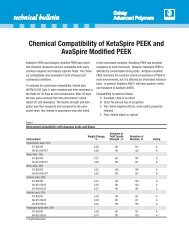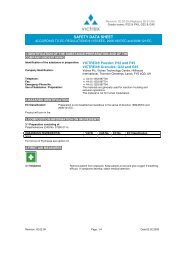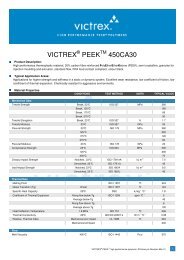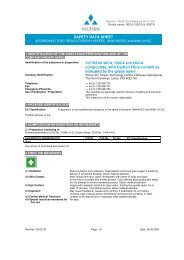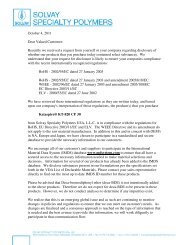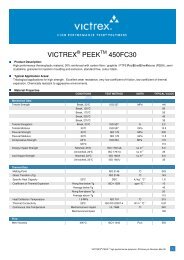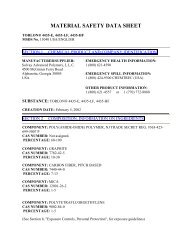Victrex 450FC30 MSDS - Drake Plastics
Victrex 450FC30 MSDS - Drake Plastics
Victrex 450FC30 MSDS - Drake Plastics
Create successful ePaper yourself
Turn your PDF publications into a flip-book with our unique Google optimized e-Paper software.
Revision: 26.01.08 (Replaces 17.12.07)<br />
Grade name: 150 FC, 450 FC<br />
SAFETY DATA SHEET<br />
ACCORDING TO EC-REGULATIONS 91/155/EEC, 2006/1907/EC and 2006/121/EC<br />
1. IDENTIFICATION OF THE SUBSTANCE/PREPARATION AND COMPANY/UNDERTAKING<br />
Identification of the substance or preparation:<br />
Company Identification:<br />
VICTREX® 150FC and 450FC compounds, with<br />
combined Carbon Fibre, Graphite and PTFE<br />
content as indicated by the grade name<br />
<strong>Victrex</strong> Plc, <strong>Victrex</strong> Technology Centre, Hillhouse International,<br />
Thornton-Cleveleys, Lancs, FY5 4QD, UK<br />
Telephone: ++ 44 (0) 1253 897700<br />
Fax: ++ 44 (0) 1253 897701<br />
Emergency Phone No. ++ 44 (0) 1253 897754<br />
Use of Substance / Preparation:<br />
The materials are generally used for injection moulding and extrusion<br />
operations. This material is not for human implantation.<br />
2. HAZARDS IDENTIFICATION<br />
EC Classification<br />
Preparation is not classified as hazardous in the sense of directive 1999/45/EC and<br />
2006/121/EC.<br />
Product will burn in fire. A potential health hazard of this composition is the inhalation of thermal decomposition products<br />
from PTFE. Contamination of tobacco products MUST be avoided. Contains carbon fibre and graphite. Dusts from this<br />
compound may be electrically conductive and can short circuit electrical equipment .<br />
3. COMPOSITION/INFORMATION ON INGREDIENTS<br />
3.1 Preparation consisting of:<br />
Polyetheretherketone (CAS No. 31694-16-3), Synthetic Graphite (CAS 7782-42-5), Carbon fibres (CAS 7440-44-0),<br />
Polytetrafluoroethylene (CAS 9002-84-0).<br />
HAZARDOUS INGREDIENT(S) %W/W CAS No. EC No. EC Classification<br />
For full text of R phrases see section 16.<br />
- - - - -<br />
Revision: 26.01.08 Page: 1/6 Date: 26.01.2008
VICTREX® 150FC and 450FC compounds, with combined Carbon Fibre,<br />
Graphite and PTFE content as indicated by the grade name<br />
4. FIRST AID MEASURES<br />
4.1 Inhalation Remove patient from exposure. Keep patient at rest and give oxygen if breathing<br />
difficult. If symptoms develop, obtain medical attention.<br />
4.2 Skin Contact After contact with skin, wash immediately with plenty of soap and water.<br />
In the event of contact with molten product: Cool affected area quickly with water.<br />
Do not attempt to remove hardened product. Obtain medical attention.<br />
4.3 Eye Contact Irrigate with eyewash solution or clean water, holding the eyelids apart, for at<br />
least 15 minutes. If symptoms persist, obtain medical attention.<br />
4.4 Ingestion May cause headache, nausea and vomiting. If swallowed, do not induce<br />
vomiting: seek medical advice immediately and show this container or label.<br />
4.5 Further Medical Treatment Unlikely to be required but if necessary treat symptomatically.<br />
4.6 Special resources necessary for No data.<br />
first aid<br />
5. FIRE FIGHTING MEASURES<br />
5.1 Extinguishing Media As appropriate for surrounding fire. Extinguish with carbon dioxide, dry chemical,<br />
foam or waterspray.<br />
5.2 Unsuitable Extinguishing Media None known.<br />
5.3 Fire Fighting Protective Equipment Protective respirator with independent air supply. Full protection, if necessary.<br />
5.4 Special exposure hazards arising In case of fire the following can develop: When glowing and during combustion,<br />
from the substance or preparation CO/CO2 is generated as well as the potential for the release of degradation<br />
itself, combustion product, products such as Hydrogen Fluoride, Tetrafluoroethylene, Hexafluropropylene,<br />
resulting gases.<br />
Perfluoroisobutylene and Carbonyl Fluoride. Product will burn, but smoke<br />
emission is low. Dust is ignitable but will not sustain combustion. A high<br />
temperature source of ignition is required. Insensitive to sparks. The minimum<br />
spark energy required for ignition of a dust cloud is greater than 5000 mJ. It will<br />
not train fire, e.g. along beams etc.<br />
5.5 Other Dispose of contaminated extinction water according to official regulations.<br />
6. ACCIDENTAL RELEASE MEASURES<br />
Refer to Section 13 and for personal protection refer to section 8<br />
6.1 Personal Precautions Avoid inhalation and contact with eyes or skin. Ensure sufficient supply of air. Avoid<br />
build up of dust. Remove possible cause of ignition – do not smoke. Take<br />
precautionary measures against static discharges.<br />
6.2 Environmental Exposure Controls Avoid release to the environment. Prevent surface and ground water infiltration, as<br />
well as ground penetration.<br />
6.3 Methods for cleaning up Collect mechanically and dispose of according to Section 13. Avoid build up of dust.<br />
7. HANDLING AND STORAGE<br />
7.1 HANDLING See Section: 6.1. General hygiene measures for the handling of chemicals are<br />
Revision: 26.01.08 Page: 2/6 Date: 26.01.2008
VICTREX® 150FC and 450FC compounds, with combined Carbon Fibre,<br />
Graphite and PTFE content as indicated by the grade name<br />
applicable. This is particularly important due to the presence of PTFE. Observe<br />
directions on label and instructions for use. Avoid conditions where decomposition<br />
products may be formed. When using do not smoke. Eating, drinking, smoking, as<br />
well as food storage, is prohibited in work room. Avoid build up of dust. Local<br />
Exhaust Ventilation at the workplace or on the processing machines required.<br />
Note: Danger of explosive dust<br />
Contamination of tobacco products MUST be avoided. “Polymer Fume Fever” is<br />
particularly associated with the smoking of contaminated tobacco products. This<br />
condition is characterised by influenza-type symptoms occurring a few hours after<br />
exposure and lasting up to 48 hours.<br />
PTFE begins to decompose very slowly above 260°C and increases rapidly above<br />
360°C. Processing above these temperatures yields a range of high toxicity and<br />
corrosive products and therefore is not recommended without the use of LEV.<br />
Machine Cleaning (purging): Purging with other polymers (e.g Polyethylene) at high<br />
temperatures can be hazardous. They may emit decomposition fumes which<br />
contain oxides of carbon and irritants. Auto ignition may also occur. Local exhaust<br />
ventilation is required. The relevant Safety Data Sheet for the purge material to be<br />
used should be consulted. Additional information on the properties, processing and<br />
application of VICTREX polymers is available at www.victrex.com.<br />
7.2 STORAGE Requirements for storage rooms and containers:<br />
Not to be stored in gangways or stair wells. Store products enclosed, in original<br />
packing.<br />
Special storage conditions:<br />
See Section: 10.2. Store in dry place.<br />
Storage Temperature:<br />
Ambient.<br />
Storage Life:<br />
Stable at ambient temperatures.<br />
Specific use:<br />
Industrial use only.<br />
8. EXPOSURE CONTROLS/PERSONAL PROTECTION<br />
Ensure adequate ventilation. This can be achieved by local exhaust ventilation or general ventilation. If this is insufficient<br />
to maintain the concentration under the WEL or TRGS 900 values, suitable breathing protection should be worn. Applies<br />
only if maximum permissible exposure values are listed here.<br />
OCCUPATIONAL EXPOSURE LIMITS<br />
SUBSTANCE. CAS No. LTEL (8 hr<br />
TWA ppm)<br />
Dust. (general dust limit value) -<br />
Fibre dust inorganic<br />
LTEL (8 hr STEL (ppm) STEL Note:<br />
TWA mg/m³)<br />
(mg/m³)<br />
10 Inhalable Dust.<br />
4 Respirable Dust.<br />
2 fibres/ml,<br />
5 mg/m3<br />
WEL: Workplace Exposure Limit (UK HSE EH40)<br />
Revision: 26.01.08 Page: 3/6 Date: 26.01.2008
VICTREX® 150FC and 450FC compounds, with combined Carbon Fibre,<br />
Graphite and PTFE content as indicated by the grade name<br />
8.1 Respirators Wear suitable respiratory protective equipment if exposure to levels above the<br />
occupational exposure limit is likely.<br />
8.2 Eye Protection Eye protection with side protection (EN 166)<br />
8.3 Gloves Impervious Gloves. Plastic or synthetic rubber gloves.<br />
Additional information on hand protection – No tests have been performed.<br />
When dealing with heated material: Insulating gloves EN 407 (heat).<br />
8.4 Other Protective working garments (e.g. safety shoes EN 344, long sleeved protective<br />
working garments).<br />
9. PHYSICAL AND CHEMICAL PROPERTIES<br />
Form<br />
Colour<br />
Odour<br />
pH (Value)<br />
Boiling Point (°C)<br />
Melting Point (°C)<br />
Flash Point (°C)<br />
Auto Ignition Temperature (°C)<br />
Explosive Properties<br />
Oxidising Properties<br />
Vapour Pressure (Pascal)<br />
Density (g/ml)<br />
Solubility (Water)<br />
Electrical properties<br />
Solid. (Granulate)<br />
Black.<br />
Odourless.<br />
Not known.<br />
Not known.<br />
343<br />
Not known.<br />
595<br />
May form explosible dust clouds in air.<br />
Not applicable.<br />
Not known.<br />
FC30~1.4<br />
Not applicable.<br />
Contains carbon fibre and graphite. Dusts from this compound may be<br />
electrically conductive.<br />
10. STABILITY AND REACTIVITY<br />
10.1 Conditions to avoid See Section: 7. Stable when handled and stored correctly. Electrostatic charge.<br />
Open flame, ignition sources. Decomposes at temperatures above (°C): 450. PTFE<br />
begins to decompose very slowly above 260°C and increases rapidly above 360°C.<br />
10.2 Materials to avoid See Section: 7. Concentrated Sulphuric acid.<br />
10.3 Hazardous Decomposition See Section: 5.4<br />
Product(s)<br />
11. TOXICOLOGICAL INFORMATION<br />
The following information is based on a consideration of the properties of the main components of this mixture.<br />
11.1 Ingestion Predicted to be low toxicity under normal conditions of handling and use.<br />
11.2 Inhalation May cause irritation to the respiratory system.<br />
11.3 Skin Contact Repeated and/or prolonged skin contact may cause irritation.<br />
In the event of contact with molten product: Thermal Burns (molten polymer will<br />
adhere to skin and cause severe burns).<br />
Revision: 26.01.08 Page: 4/6 Date: 26.01.2008
VICTREX® 150FC and 450FC compounds, with combined Carbon Fibre,<br />
Graphite and PTFE content as indicated by the grade name<br />
11.4 Eye Contact May cause eye irritation. Permanent damage is unlikely.<br />
11.5 Long Term Exposure Chronic effects are unlikely.<br />
12. ECOLOGICAL INFORMATION<br />
12.1 Environmental Fate and Distribution Insoluble in water. The product has low mobility in soil.<br />
12.2 Persistence and Degradation The product is not biodegradable.<br />
12.3 Toxicity Low toxicity to aquatic organisms.<br />
12.4 Effect on Effluent Treatment Unlikely to affect biological treatment processes.<br />
12.5 Water hazard class: Not classified.<br />
13. DISPOSAL CONSIDERATIONS<br />
13.1 Regulatory information Do not allow to enter drains, sewers or watercourses. Disposal should be in<br />
accordance with local, state or national legislation.<br />
13.2 E.C disposal code no: The waste codes are recommendations based on the scheduled use of this<br />
product. For alternative uses and applications, other waste codes may be<br />
allocated under certain circumstances.<br />
07 02 13- waste plastic. 07 02 99- waste not otherwise specified.<br />
13.3 Recommended: Containers must be decontaminated in accordance with all applicable<br />
regulations.<br />
14. TRANSPORT INFORMATION<br />
International Transport Regulations<br />
Not Classified as Dangerous for Transport.<br />
UN No.:<br />
Not applicable.<br />
Road/Rail Transportation (ADR/RID): Not applicable.<br />
Class/Packing Group:<br />
Not applicable.<br />
Classification code:<br />
Not applicable.<br />
LQ:<br />
Not applicable.<br />
EmS:<br />
Not applicable.<br />
15. REGULATORY INFORMATION<br />
Classification according to Dangerous Product Regulations incl. EC Directives 67/548/EEC, 1999/45/EC and 2006/121/EC.<br />
EC Classification<br />
Not classified as dangerous for supply/use.<br />
Hazard Symbol<br />
Not applicable.<br />
Risk Phrases<br />
Not applicable.<br />
Safety Phrases<br />
Not applicable.<br />
Observe restrictions<br />
VOC 1999/13/EC<br />
INTERNATIONAL INVENTORIES<br />
EINECS (Europe)<br />
EINECS: Included.<br />
Revision: 26.01.08 Page: 5/6 Date: 26.01.2008
VICTREX® 150FC and 450FC compounds, with combined Carbon Fibre,<br />
Graphite and PTFE content as indicated by the grade name<br />
16. OTHER INFORMATION<br />
Manufactured in the UK under a Quality System approved to ISO 9001:2000 by <strong>Victrex</strong> Plc.<br />
This Safety Data Sheet was prepared in accordance with Directive 2001/58/EC.<br />
The following sections contain revisions or new statements: 1 - 16<br />
Additional information on the properties, processing and application of VICTREX polymers is available at www.victrex.com.<br />
These details refer to the product as it is delivered.<br />
The statements made here should describe the product with regard to the necessary safety precautions – they are not<br />
meant to guarantee definite characteristics – but they are based on our present up-to-date knowledge.<br />
Revision: 26.01.08 Page: 6/6 Date: 26.01.2008



